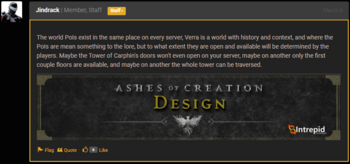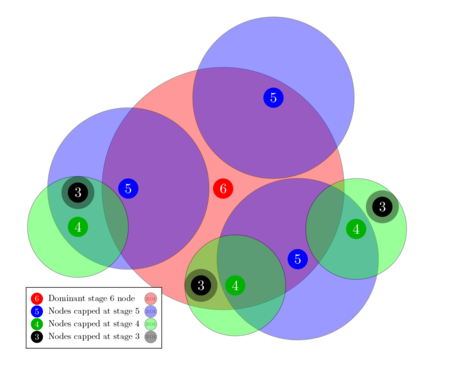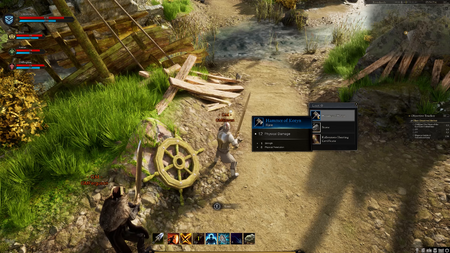世界管理員
The 世界管理員 is an algorithm in Ashes of Creation that controls dynamic world elements. It acts as both a throttle and an incentive system for various activities to ensure certain parameters are within acceptable thresholds.[1]
- A world manager is a technical term to define a server process that lives alongside the game server; and when the game server needs to do things- communicating with other game servers within that grid- it tells that manager and that manager sends it down to the appropriate server.[2] – Steven Sharif
- Prices of glint.[3]
- A heatmap of experience being gained to apply to node advancement.[3]
- The territory expansion algorithm takes into account the nearest coast, neighboring nodes, and the heatmap of players in surrounding areas over the last weeks or month.[4]
- Due to the way the progression algorithm calculates territorial (ZOI) expansion during node advancement, there is a small possibility that two nodes of the same stage end up being close to each other.[5]
- Transit of resources and goods between regions to drive quest rewards for nodes.[3]
- For example if you know iron is being used as a raw resource for a specific crafting path that might drive up the price of mithril or silver; and that will incentivize the market to course correct a little bit. The idea is to provide soft incentives that help to alleviate the demand and also to prop up the supply that might not be present from the economic systems.[3] – Steven Sharif
節點發展
玩家 (公民或非公民) 於節點的影響區域內進行活動 (任務、採集、團隊戰鬥等) 時,將有助該節點發展,提升節點至更高階段。[8][9]
隨着節點發展,其發展區域將會是出現文明的地方。節點發展至不同階段時,其發展區域內將會出現不同的建築物、NPC 和服務。節點等級愈高,發展區域便會變得愈繁盛,人口亦會變多。發展區域也會根據節點種類 (經濟、軍事、科技、神聖) 而變化。未來我們將會更詳細介紹每種節點種類。[8] – Margaret Krohn
隨着節點發展,將會有獨特遊戲內容解鎖,但其影響區域會同時擴大,限制相鄰節點的可發展等級。[10]
- 第一階段發展需時短,讓玩家可以使用售賣、存放物品等 NPC 功能。[11]
- 節點等級愈高,其影響區域愈大。[12]
- 等級較低的節點 (即附庸節點) 即使位於等級較高的節點的影響區域內,仍會獲得經驗值,但其等級不會超越上級節點。[6]
- 附庸系統將在節點發展至
[[{{{2}}}|⧼{{{2}}}⧽]] (階段 3) 時生效,但相鄰節點從
[[{{{2}}}|⧼{{{2}}}⧽]] (階段 1)便會限制鄰近節點的發展。[13][14]
The way that the algorithm expands the territories takes into account a few things: One it takes into account the coast like where's the closest coast. Two it takes into account the neighboring nodes so it can take over and essentially vassal state those nodes, but what's more important is essentially the initial population based on like how players choose their races. Because we have nine different races and four different starting points that branch out, each server's population density is going to dictate essentially the first few nodes that are highly populated and then that initial seed is what's going to determine the node structure as it moves inland into the into the world essentially; and based on the performance and successes of different sieges will determine which nodes that got locked out from the previous the initial advancements what nodes can now be available to advance further. So I really think that with so many variables that are present in the equation of how nodes advance and stay existing with the more variables you have, the higher likelihood there is for there to be a significant diversion in world progression.[4] – Steven Sharif
Normally the algorithm that's applied to the node territorial expansion will prevent significant nodes from being in close proximity to each other... There could be a perfect storm where all of the algorithmic progression of territory leads to having these nodes very close to each other because there's certain requirements that should that need to be available to satisfy node vassal takeovers; and it's possible that two nodes would never take each other over as vassals and end up close together and spanning their territories in opposite directions: The Tale of Two Cities thing.[5] – Steven Sharif
- 影響區域內的其他節點達到等級上限後,才會從這些節點獲得經驗值。[6]
- 玩家在節點升級時,與新出現的建築物處於同一位置的話,會被傳送至安全場所。[15]
- 某節點的公民仍可以協助其他節點發展。[16]
- 為了避免出現「為做而做」的情況,玩家不會明確知道節點升級實際需要多少物品或擊死多少隻怪物。[17]
Different people have different resources invested in nodes progressing and it would be a little "gamey" if you could know exactly what was necessary at that point because that would disincentivize people from participating.[17] – Steven Sharif
附庸節點
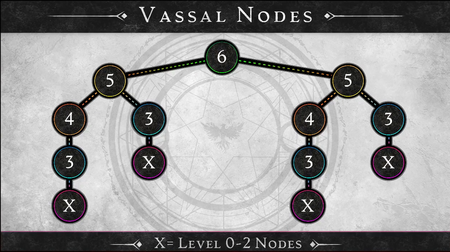
This vassal mode structure tells you what it looks like for a sovereign at a level six metropolis stage; and what it can control at a maximum vassal network is two level five nodes, of which a level five node can control one level four and one level three as direct vassals; and then the four can control a three; and every three can control a one or a two. Now if the three gets removed through siege, the one or the two is removed as well. So that's an important distinction between the three's vassals, which technically isn't really a vassal relationship because there's no citizenships possible. Those vassals don't exist between three and X, but they do exist between four and three, five and four, and six and five. And what this also allows is that because there are 85 nodes that are within the world, we have a buffer zone of about 20 nodes that lives in a max server state. So if you had maximum five metropolises form in a world, you will have a number about 20 nodes that can live alongside those metropolis networks; and when or if a metropolis falls, that extra cushion of nodes around the five metropolis structures allows for the map to be redistricted in a way that is unique. It doesn't mean that one of the fives is just going to pick up where the last six left off and form the same exact metropolis structure. From a territory perspective it has ancillary nodes to play with and expand towards that redistricts the map, so that if a metropolis falls there's a significant difference in the layout of the world and the layout of these almost nation-like territories.[18] – Steven Sharif
Village (stage 3) or higher nodes enslave nearby nodes, converting them into vassal nodes.[7][14]
- A
[[{{{2}}}|⧼{{{2}}}⧽]] (階段 6) can control up to two
[[{{{2}}}|⧼{{{2}}}⧽]] (階段 5) nodes. A
[[{{{2}}}|⧼{{{2}}}⧽]] (階段 5) can control one
[[{{{2}}}|⧼{{{2}}}⧽]] (階段 4) and one
[[{{{2}}}|⧼{{{2}}}⧽]] (階段 3) node. A
[[{{{2}}}|⧼{{{2}}}⧽]] (階段 3) can control an
[[{{{2}}}|⧼{{{2}}}⧽]] (階段 2) or an
[[{{{2}}}|⧼{{{2}}}⧽]] (階段 1). If the
[[{{{2}}}|⧼{{{2}}}⧽]] (階段 3) gets destroyed through a siege, its dependant
[[{{{2}}}|⧼{{{2}}}⧽]] (階段 2) and
[[{{{2}}}|⧼{{{2}}}⧽]] (階段 1) nodes are also destroyed.[18]
- There is a layer of intricacy between how the neighboring nodes advance and what potential parent structure they have in the vassalship tree.[19] – Steven Sharif
- Vassal nodes gain benefits from their regent node (also referred to as sovereign node or parent node) even if the node type of the parent is different to the vassal.[20][21]
- It is not a bad thing to be vasseled, it is a good thing to be vasseled. It brings many benefits from the Sovereign, which is the ultimate parent of that vassal network down to the vassal node itself; and it allows that vassal node to even live outside of its normal mechanics. You get to adopt some of the benefits that the node type of your sovereign is, even if your node type as a vassal node isn't the same.[21] – Steven Sharif
- Regent nodes collect taxes from their vassal nodes. These taxes cannot be taken by the mayor or other players.[23]
- Vassal nodes must remain at least one node stage below their parent node.[7]
[[{{{2}}}|⧼{{{2}}}⧽]] (階段 1) upward block the growth of their immediate neighbors. This was intended to be tested in Alpha-1.[13][14]
- Vassal nodes give excess experience to their parent node and may have their own vassals; so long as they fall within the parent node’s zone of influence.[23][7]
- If a node is capped and is both a vassal and has its own vassals, any experience earned from itself or its Vassals is first applied to its own deficit. Experience beyond that is then sent to its parent node.[8]
- When the vassal reaches its cap it overflows experience up to the parent; and so it can be very good early on for parents to get vassal nodes that are very productive- that have a lot of traffic.[23] – Steven Sharif
- Vassals are subject to the government, alliances, wars, taxes, and trade of their parent node, and are able to receive federal aid from them.[7]
- Vassal nodes cannot declare war on their parent node or any of their vassals.[7]
- Citizens of vassals are bound by the diplomatic states of the parent node.[7]
- If a Node is a Vassal Node and is capped from advancing further, it first applies any experience earned to its own deficit (see Node Atrophy section), and then applies excess experience earned to its Parent Node. If the Parent Node advances and the Vassal is able to grow, it becomes uncapped. If a Node is capped and is both a Vassal and has its own Vassals, any experience earned from itself or its Vassals is first applied to their own deficit. Any experience beyond that is then sent to its Parent Node.[8] – Margaret Krohn
Adjacent nodes
Adjacent nodes (Neighboring nodes) starting from
[[{{{2}}}|⧼{{{2}}}⧽]] (階段 1) may block (lockout) the growth of their immediate neighbors.[13][14]
- 附庸節點 must remain at least one node stage below their parent node.[7]
[[{{{2}}}|⧼{{{2}}}⧽]] (階段 2) and
[[{{{2}}}|⧼{{{2}}}⧽]] (階段 1) nodes are technically not vassal nodes as they do not support citizenships. If their parent
[[{{{2}}}|⧼{{{2}}}⧽]] (階段 3) node is destroyed by a node siege, these nodes are also destroyed.[18]
Loot tables
- Mobs drop glint, 物品, and crafting materials in preference to gold.[25][26]
- Glint is not bound to a specific region and can be also dropped by players on death as stolen glint, based on applicable death penalties.[27][28][29][30][25][31]
- The rarity of glint increases with the mob's level.[32]
- Loot tables are disabled for player controlled monsters.[33]
- There is a small 隨機性 chance of looting rare and legendary items or crafting materials from mobs based on the level, status and type of mob. This also applies to harvesting resources with a gathering profession.[34]
- Experience debt decreases the drop rate percentages from monsters.[35]
- Loot (loot tables) from world bosses or dungeon bosses has a small 隨機性 chance of dropping gear (completed items).[36][37]
- There is a much higher chance that materials and unique recipes are dropped that can be used to craft items of equitable value.[36][38][39]
- Legendary equipment is only dropped by Legendary world bosses.[40]
- Loot tables will likely not be affected by weather conditions.[42] This was previously listed as a possible effect.[43]
- There won't be specific loot drops for artisans.[44] Previously it was stated that master gatherers may have the ability to "spoil" a boss' loot.[45]
- Q: Can only one gathering artisan harvest resources from a single boss, or can multiple different artisans harvest different parts from a boss for different resources? For example, a lumberjack gets a special wood from Tumock's tree weapon, while a herbalist gathers the flowers from that same tree.
- A: We don't have the concept of harvesting from bosses. NPCs follow a reward table format, where those reward tables are global. They're not unique to particular players. So, once the NPC is vanquished, you have access to the loot container that is its corpse; and it has a static value of either materials or items that get dropped; and whatever the party loot settings are that you might be a part of, or if you're a solo player you will be able to recover those things.[44]
经济

The economy is usually something that happens in the background of other games. From day one we knew that the economy was going to be something really important to us.[47] – Jeffrey Bard
The economy in Ashes of Creation is regionalized.[48][49][50]
- Gatherable resources shift locations as they’re exhausted, this will keep people moving about the world, seeking out the best resources for their crafting builds, and the best markets for their goods.[51][52][53][54][50]
- There is no central auction house or warehouse.[55][50]
- Auction houses in up to two economic metropolises (including their vassal nodes) can be linked with the linked economy superpower.[56]
- There will be item decay (material sinks), deconstruction mechanics and other gold sinks to combat inflation.[57][58]
- The developers are considering the use of adaptive price points in merchant shops based on the amount of gold being generated or sunk in the economy.[57]
- There will be player to player trading.[59][60]
- The primary method to generate gold in the economy is through glint, which is a bound currency that drops from mobs and players, and is offered as a reward for completing certain quests, events, and achievements.[61][62][28][63][25][26]
- Economic systems require scarcity. And in a game, all scarcity is artificially created in an attempt to simulate supply/demand structures or as we would call them points of player friction. You may progress within your processing profession by being a member of a guild or family of a person who owns a freehold and has setup the infrastructure necessary for t4-5 processing. With the intent that players will be able through effort to find a way of progressing and accessing late game processing. If that is not the case through testing then we will adjust the designs as necessary in order to achieve the systems.[64]
Population based scaling
The prices that NPCs sell items for will scale based on the economic activity on a server. Prices will rise to combat inflation and fall as a population diminishes.[65]
The node system allows the developers to scale the experience needed to level a node and the attrition that affects a node based on activity.[65]
Things that NPCs buy and sell scale based on the economic activity that exists on that server... As inflation rises, prices rise and everything ends up being equal, even though there might be a couple of extra zeros. So that can go up and it can also go down so as a population leaves, things become less expensive and players don't have to do as much to earn that. On the other side of things we look at the node system and the node system is set up in this really flexible way that allows us to scale the experience needed to level a node and the attrition that delevels a node to scale based on activity too. So it's just a matter of adjusting a couple of constants and that goes up and down and the server can watch it and change those on the fly as it needs to.[65] – Jeffrey Bard
Adaptive content
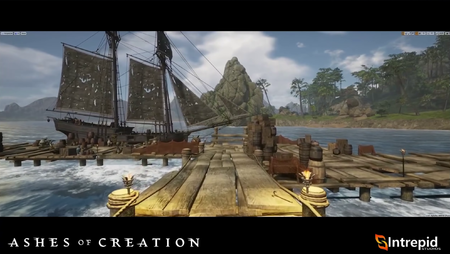
This is actually a dynamic POI. This one will evolve as players evolve the node that it's attached to. So this is its final state.[66] – Jeffrey Bard
New points of interest (such as dungeons, world bosses, and corrupted areas) spawn as nodes develop.[67][68] This content adapts to the node progression of the zone it is in.[66][69]
- Additional buildings will spawn.[66]
- Additional mobs will spawn.[66]
- Different antagonists/leaders with different story lines.[66][69]
- Populations will change.[69]
- Content difficulty will change.[69]
- The content may be different altogether.[69]
- Additional quest hooks.[66]
- 地下城 will be unlocked when certain nodes advance to certain stages.[70]
- Drop tables in areas and dungeons will be tied into the progression of certain areas.[70]
- POI events are events that relate to specific points-of-interest (POI).[73]
- The location of points of interest will be the same on each server, but some servers may have limited or no access to them.[74]
- Certain dungeons and other points of interest across the map will all be affected by the server’s node development. Some dungeons will only be unlocked if nodes are developed to certain stages. The storyline objectives for players inside dungeons will also be dependent on the story arc paths chosen through the node system. The drop tables in area and dungeons will also be tied into the progression of certain areas. For example, let’s say that the humans have developed a node in Region A, and a storyline has opened up that leads players to inspect the ruins (dungeon) of a nearby area. And let’s say that this node was developed in a scientific (crafting) zone… Well before the node developed, this dungeon was accessible… But now the dungeon has propagated new monster assets that include a drop table catering to a crafting emphasis because of the development of that academic node. And perhaps, a new boss appears in different rooms of the dungeon that includes different adventure quest starts, like a mysterious item with a storyline that can only be progressed if a node develops to the metropolis stage in a certain region, across the world. Our system is so vast, when it comes to interconnectivity and how the world reacts to the players.[70]
其他
引用
- ↑ 訪談, 2020-07-19 (1:10:55).
- ↑ 直播, 2022-10-14 (57:22).
- ↑ 3.0 3.1 3.2 3.3 訪談, 2020-07-19 (1:08:22).
- ↑ 4.0 4.1 4.2 訪談, 2020-07-18 (10:04).
- ↑ 5.0 5.1 5.2 訪談, 2020-07-08 (1:00:15).
- ↑ 6.0 6.1 6.2 直播, 2017-10-16 (50:20).
- ↑ 7.0 7.1 7.2 7.3 7.4 7.5 7.6 7.7 7.8 Blog - Know Your Nodes - The Basics.
- ↑ 8.0 8.1 8.2 8.3 8.4 Blog - Know Your Nodes - Advance and Destroy.
- ↑ A reactive world - Nodes.
- ↑ 影片, 2017-04-20 (0:02).
- ↑
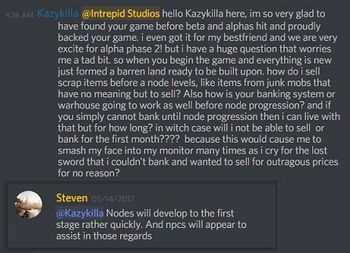
- ↑ Node series part II – the Metropolis.
- ↑ 13.0 13.1 13.2

- ↑ 14.0 14.1 14.2 14.3

- ↑ 直播, 2017-11-17 (55:27).
- ↑
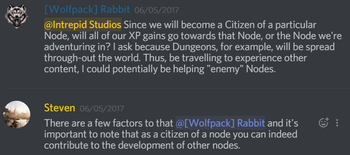
- ↑ 17.0 17.1 直播, 2017-05-26 (28:16).
- ↑ 18.0 18.1 18.2 18.3 直播, 2022-08-26 (1:07:34).
- ↑

- ↑ 直播, 2023-08-31 (52:56).
- ↑ 21.0 21.1 直播, 2022-08-26 (1:04:35).
- ↑

- ↑ 23.0 23.1 23.2 直播, 2022-08-26 (1:10:16).
- ↑ 影片, 2023-01-27 (16:44).
- ↑ 25.0 25.1 25.2 訪談, 2020-07-18 (27:11).
- ↑ 26.0 26.1 直播, 2017-05-24 (44:14).
- ↑

- ↑ 28.0 28.1 訪談, 2023-09-10 (53:47).
- ↑ 直播, 2021-03-26 (1:07:33).
- ↑

- ↑ Podcast, 2017-05-05 (43:05).
- ↑

- ↑ 直播, 2017-05-03 (35:25).
- ↑ 訪談, 2020-07-18 (1:00:15).
- ↑ Ashes of Creation Forums - Former Lineage 2 PvP'er wanting to discuss PvP loopholes.
- ↑ 36.0 36.1 訪談, 2020-07-19 (8:43).
- ↑ February 8, 2019 - Questions and Answers.
- ↑ 訪談, 2020-07-20 (21:57).
- ↑ 直播, 2018-04-8 (PM) (55:49).
- ↑ 40.0 40.1 直播, 2020-07-25 (46:08).
- ↑ 直播, 2020-12-22 (1:15:01).
- ↑ 直播, 2022-05-27 (1:14:46).
- ↑ 影片, 2022-05-27 (2:21).
- ↑ 44.0 44.1 直播, 2024-02-29 (1:22:09).
- ↑ Podcast, 2018-08-04 (1:44:54).
- ↑ Ashes of Creation Press Kit.
- ↑ 影片, 2017-04-30 (8:02).
- ↑

- ↑

- ↑ 50.0 50.1 50.2 Unreal Engine Interview, 2017-05-23.
- ↑ 直播, 2022-05-27 (1:00:23).
- ↑ 直播, 2020-07-31 (1:05:58).
- ↑ 直播, 2020-07-25 (1:04:50).
- ↑ 直播, 2017-05-08 (54:26).
- ↑

- ↑

- ↑ 57.0 57.1 Podcast, 2021-04-11 (31:02).
- ↑ 直播, 2017-05-10 (10:47).
- ↑ 直播, 2017-05-15 (10:32).
- ↑ 直播, 2018-01-18 (46:56).
- ↑ 直播, 2023-10-31 (1:06:32).
- ↑ 影片, 2023-10-31 (3:34).
- ↑ 直播, 2021-10-29 (1:06:31).
- ↑

- ↑ 65.0 65.1 65.2 直播, 2018-06-04 (39:15).
- ↑ 66.0 66.1 66.2 66.3 66.4 66.5 66.6 直播, 2021-03-26 (50:33).
- ↑ 直播, 2021-03-26 (22:53).
- ↑ 直播, 2017-11-17 (36:22).
- ↑ 69.0 69.1 69.2 69.3 69.4 直播, 2017-11-17 (18:29).
- ↑ 70.0 70.1 70.2 70.3 MMOGames interview, January 2017
- ↑

- ↑

- ↑ 直播, 2022-04-29 (40:21).
- ↑
